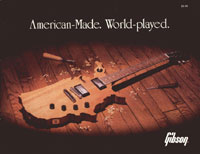

An early promotional image of the Gibson Victory MV2 in Candy Apple Red finish. Note the all-black Magna II bridge pickup

Promotional image of the Gibson Victory MVX
The Gibson Victory MV range of guitars comprised just two models: the Gibson Victory MV2 (or MVII), "designed primarily for the discerning country player", and the Gibson Victory MV10 (or MVX) that "produces a myriad of separate and distinct electric guitar tonalities; those voices that fill all the needs and requirements of the dedicated guitarist"
MV stood for multi-voice. They were created by the Gibson research and development team in Kalamazoo, MI, with the body work by Chuck Burge, and the multi-voice electronics by Tim Shaw. They featured numerous new innovations, including the new "top adjust" Tune-O-Matic bridge, and a series of specially designed pickups, in an "unbalanced" configuration; i.e. all five pickups across the range (three in the MVX, two in the MVII) are different, and specifically designed for the role it was assigned.
The period of production was short: mid 1981 - 1983/4. Early models were Kalamazoo-built, but by the end of 1981 they were being produced at the Gibson Nashville plant. There were also three Gibson Victory bass models (See Chuck Burge's interview with FlyGuitars on the development of the Gibson Victory bass), and these went on to outlast the guitar versions by several years. The Gibson Victory MV2 and MVX were last listed in Gibson prices list of January 1984, whilst the Gibson Victory Standard and Artist basses remained until 1986.
According to the 1981 pre-owners manuals, they were attempts to add "in-demand" tones, to Gibson's classic sounds. Direct competition for the Fender Telecaster (MV2) and Fender Stratocaster (MV10). As well as the Fender-esque shape, these guitars were fitted with pickups and circuitry that could give single coil tones. This was not the first time Gibson had created guitars to directly take on Fenders sound; the Gibson Marauder and Gibson S-1 had done much the same thing 6 years earlier, but with more traditional Gibson body styling.
In mid 1981, Gibson awarded it's UK distribution to Rosetti. The image to the left (taken from the cover of the 1981 Rosetti gibson catalogue) shows the Rosetti trade stand at the 1981 British Music Fair - resplendent in its Victorys. Gibson market development manager Bruce Bolen plays the then-new ES-335 Dot whilst Dave Roberts is on a Victory MV-II. Note the blue MV-X with very unusual white scratchplate in the foreground, and Victory Standard bass on the back wall.
But to say the Victory series were just Fender copies would be very wrong indeed. Although they could produce single-coil sounds, these guitars were actually fitted with humbuckers for the fatter tones associated with Gibson, and along with a hard rock maple body and a set (glued-in) maple neck, they owed a lot more to Gibson tradition than might seem obvious at a first look. In many ways they are descendants of the all-maple Gibson RD series guitars; one of the design team's previous efforts.
The original Victory MVX advert Sounds Like... All Of 'Em (included here), includes a number of popular guitars of the time, by Gibson (Les Paul), Fender (Stratocaster) and G&L (F100).
The Victory guitar series were available at dealers from late summer 1981, however bass models were most likely available slightly earlier in 1981; only Victory basses were listed in the April 1981 price lists, with the guitars added in the next list.

The Gibson Victory Standard bass and Gibson Victory MVX guitar were the only Victory models to appear in the 1983 Gibson catalogue
By this time Gibson were having serious financial problems, and unprofitable models were being discontinued. The Victory MV guitars were exceptional quality instruments, with wide tonal palettes, and widely under-estimated today. So why were they a commercial failure? It was a time of falling guitar sales in general, and perhaps Gibson buyers wanted Gibson classic styling? Price may also have been a factor: in 1982 the MV2 cost the same as the SG Standard, with the MVX a shade below the Les Paul Standard. Another factor may have been insufficient advertising. The MV2 never appeared in a Gibson Catalog (although they were included in the 1981 pre-owners folder), whilst the MVX just made it into the 1983 catalogue. Marketing the MV2 as a country guitar was perhaps a bad idea - although useful in alikening the instrument to the Telecaster, the Victory body shape was probably too 'rock' for country players, whilst the country tag must have put off may rock players.
$2097
$4295
$397
$200
$1999
$1899
$2900
£1869
£1850